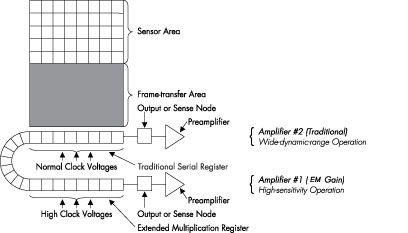Electron-Multiplying (EM) Gain
Formerly referred to as “on-chip multiplication gain”, this technology enables multiplication of charge (i.e., electrons) collected in each pixel of the CCD’s active array. Secondary electrons are generated via an impact-ionization process that is initiated and sustained when higher-than-typical clock voltages (up to 50 V) are applied to a special “extended” portion of the CCD’s serial register.
The level of EM gain can be controlled by either increasing or decreasing the voltage; the gain is exponentially proportional to the voltage. Multiplying the signal above the read noise of the output amplifier enables ultra-low-light detection at high operation speeds. EM gain can exceed 1000x.
It is possible to adapt this technology to all current CCD architectures. The illustration below depicts a frame-transfer device.

Some cameras with EM gain utilize two output amplifiers: (1) an “EM gain” amplifier that enables the camera to be used for low-light, high-speed applications and (2) a “traditional” amplifier for wide-dynamic-range applications.
